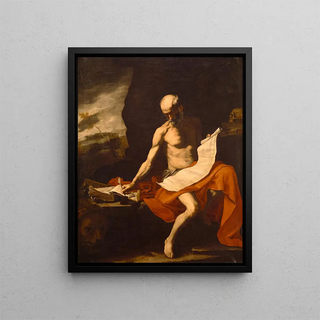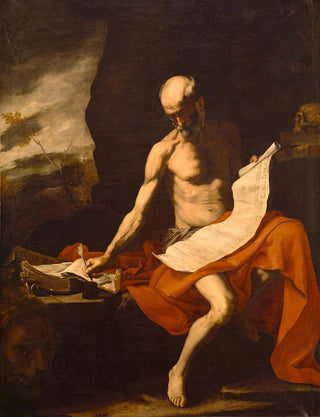Art print | Saint Jerome in the Wilderness - School of Jusepe de Ribera


View from behind

Frame (optional)
In the captivating world of baroque art, the art print "Saint Jerome in the Desert" from the school of Jusepe de Ribera stands out for its emotional intensity and spiritual depth. This iconic representation of the saint, a major figure in Christianity, immerses the viewer in an exploration of solitude and meditation. The artwork not only depicts Jerome's ascetic life but also portrays an intimate dialogue between man and the divine—a recurring theme in Ribera's work. Light, shadows, and textures intertwine to create an atmosphere that is both dramatic and serene, inviting prolonged contemplation.
Style and uniqueness of the art print
Ribera's style, often described as tenebroso, is expressed here through a remarkable chiaroscuro. Deep shadows envelop the saint, while a soft light illuminates his face and hands, emphasizing his meditative expression. The color palette, dominated by earthy tones and warm nuances, enhances the impression of human warmth and authenticity. Every detail, from the open book to the wooden cross, demonstrates meticulous craftsmanship, revealing the complexity of Jerome's thoughts. The artist manages to capture the very essence of the saint, oscillating between intellectual wisdom and spiritual fervor. This art print, with its striking realism and contemplative atmosphere, stands out in the 17th-century artistic landscape, offering a unique vision of the sacred.
The artist and his influence
Jusepe de Ribera, often associated with the Spanish school, left a lasting mark on his era through an innovative approach to religious painting. Born in Spain but having worked in Italy, he was deeply influenced by Caravaggio, whose taste for realism and dramatic effect he incorporated. Ribera transcended these influences to develop a personal style characterized by emotional intensity and unparalleled expressiveness. His work also left a durable imprint on subsequent generations of artists, particularly in Spain and Italy, where he inspired many baroque painters.

Matte finish

View from behind

Frame (optional)
In the captivating world of baroque art, the art print "Saint Jerome in the Desert" from the school of Jusepe de Ribera stands out for its emotional intensity and spiritual depth. This iconic representation of the saint, a major figure in Christianity, immerses the viewer in an exploration of solitude and meditation. The artwork not only depicts Jerome's ascetic life but also portrays an intimate dialogue between man and the divine—a recurring theme in Ribera's work. Light, shadows, and textures intertwine to create an atmosphere that is both dramatic and serene, inviting prolonged contemplation.
Style and uniqueness of the art print
Ribera's style, often described as tenebroso, is expressed here through a remarkable chiaroscuro. Deep shadows envelop the saint, while a soft light illuminates his face and hands, emphasizing his meditative expression. The color palette, dominated by earthy tones and warm nuances, enhances the impression of human warmth and authenticity. Every detail, from the open book to the wooden cross, demonstrates meticulous craftsmanship, revealing the complexity of Jerome's thoughts. The artist manages to capture the very essence of the saint, oscillating between intellectual wisdom and spiritual fervor. This art print, with its striking realism and contemplative atmosphere, stands out in the 17th-century artistic landscape, offering a unique vision of the sacred.
The artist and his influence
Jusepe de Ribera, often associated with the Spanish school, left a lasting mark on his era through an innovative approach to religious painting. Born in Spain but having worked in Italy, he was deeply influenced by Caravaggio, whose taste for realism and dramatic effect he incorporated. Ribera transcended these influences to develop a personal style characterized by emotional intensity and unparalleled expressiveness. His work also left a durable imprint on subsequent generations of artists, particularly in Spain and Italy, where he inspired many baroque painters.






